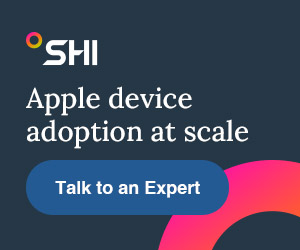Apple has a reputation for prioritizing accessibility features across its various platforms. While some of these accessibility features go mainstream, most go unnoticed by the majority of users. But for those who need them, these features set Apple’s devices apart.
In this episode, we talk to Beau Ray, a cybersecurity expert at Stratascale, who shares how Apple’s accessibility features have significantly impacted his professional and personal life.
In his late 20’s, Beau was diagnosed with Stargardt disease, a form of macular degeneration that affects central vision, causing blind spots and flashing while generally leaving peripheral vision intact. This makes tasks requiring depth perception particularly challenging.
Accessibility is Key
For any large organization, accessibility needs to be a priority, especially when it comes to technology. Allowing employees with impairments to choose devices that suit their needs and help them work more effectively is empowering in a number of ways.
For Beau, Apple's commitment to accessibility has been a game-changer. The consistency and integration of accessibility features across Apple’s ecosystem— system-wide font sizes, text-to-speech, zoom, and magnifying tools, to name a few—have empowered him to perform his job in ways he may not be able to otherwise.
“When it comes to helping the visually impaired connect with technology, which then leads to connecting with the rest of the world, Apple, to me, has done the best with that,” Beau says.
While the merits of Apple’s stringent development guidelines are endlessly debated, they do ensure that accessibility features work seamlessly across most apps, which is crucial for users like Beau. This consistency means less time spent tinkering with settings and more time being productive.
Family Dynamics
For Beau’s young daughter who was also diagnosed with Stargardt disease, common family activities like watching television together can become a solitary experience. “When you're visually impaired and everybody else is...visually normative, they're seeing it just fine. They're engaged or laughing or whatever,” Beau says. “My daughter's kind of left on the outside of that. She's there with us, but she's not engaged in the activity with us.” This highlights the broader social implications of accessibility and the need for inclusive technology.
Emerging spatial computing devices like Apple’s Vision Pro could introduce new possibilities in these kinds of situations. Since Apple generally keeps inclusivity top-of-mind, accessibility features are already widespread throughout visionOS, offering many of the same customizations as Apple’s other platforms. The large virtual entertainment screens and immersive environments of visionOS, as well as spatial Personas that appear in the room with you, can create a more inclusive environment that gives everyone an equal opportunity to enjoy that kind of experience.
The Future of Accessibility
Looking ahead, Beau stressed the importance of technology companies engaging with diverse communities to better understand their needs. More and more, accessibility features are seamlessly integrated into everyday devices, so it’s crucial that tech companies continue to innovate and prioritize inclusivity. It’s also imperative for organizations to consider their overall digital employee experience to ensure they’ve created an inclusive workplace. By doing so, they not only empower individuals with impairments but also enrich the user experience for everyone.
As Victoria aptly puts it, the goal is to ensure that people with disabilities don’t have to ask for special accommodations. Instead, the technology we use daily should be flexible and adaptable enough to meet diverse needs, creating a more inclusive world for all.
---
Be sure to check out WeGotYourMac.com for more episodes and content on Mac adoption and other end-user computing topics.
This episode of We Got Your Mac is presented in collaboration with SHI’s Mac Readiness Assessment. For a limited time, eligible customers who complete the assessment get a free trial of top-tier MDM solutions like Jamf Pro or Kandji. Visit SHI.com/MacAssessment today to see how SHI can unlock the full potential of your Apple fleet.




